|
Kgalagadi Transfrontier Park
Complicated Logistics
I had made the resolution to check out the unique Kalahari Lions in the Kgalagadi Transfrontier Park. It is not possible to travel by bike in the National Park, so I decided to rent a car. As usual, I had not arranged anything in advance, it was not even possible, as the Internet access was really miserable there. The only car rentals available in Upington are at the Airport. Only three out of six car rental offices were open. The only car available immediately to me was a VW Polo from Hertz. The bike would not fit in it, only if I cut it into pieces.
Although the Airport boasts the reportedly longest runway in the southern hemisphere (4,900 m), there is no facility for luggage storage. I asked Hertz if they had a storeroom or garage, but apparently they had nothing like that. So I visited the Airport administrative department and they finally, after the decision of the most senior boss present, leased me a storeroom the size of a garage, which affiliated companies could rent for the minimum period of one month. The price was not entirely cheap, but in combination with the cheapest car, it cost about the same as a bigger vehicle would have. Putting the bike in the depository was a martyrdom. At airports today, security procedures are required for everything. The ordinary workers refused to deal with anything which is not specified in their instructions and so they called their superior. He called his manager. So I spoke to the top boss who sent me to the security workers, they called their superiors and eventually this matter returned to the top boss again like a boomerang, so the warehouse had to opened by him. Sure, security is a bitch.
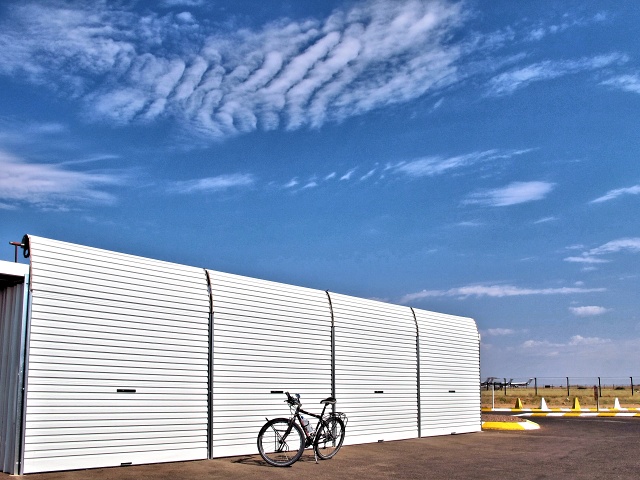
[Upington] At the Airport, I rented a storeroom for the bike
Although it was not cheap, it still paid off. In comparison with the three-day excursion offered by Kgalagadi Safaris in Upington for more than 6,000 Rands, I paid less than half of that. Yet I did everything I wanted to and did not have to depend on other participants of an organized trip. And I also did not have to wait until a sufficient number of people applied, as the excursions are organized with the minimum of four paying persons.
Left-handed Gear Change
Thanks to automatic transmissions, I had already forgotten how to change gears manually. Moreover, the Polo gear change was rather inaccurate, although it had less than 30,000 km on the clock. In addition, the gears are changed with the left hand. It gave me a hard time. I drove carefully from the Airport and practiced accelerating on the open road, adjusted the distance of the seat to the steering wheel, and drove into the town. First of all, I booked a campsite in the Park at an Information center, then bought supplies of food and drinks. As I drove through the town, I was careful to keep on the left side of the road when turning. This is easy on the bike, but one has deeply-rooted stereotypes in a car. After leaving the town, driving was easy. I drove in 5th gear and only changed gears 190 km later when I arrived at Askham. There was the minimum of traffic on the road, no speed-restricting settlements, so the trip was pretty quick.

[Askham] Copies of the original dwellings serve as stalls selling tourist items – at this time, nobody was around
Kgalagadi Tranfrontier Park
The name "Kalahari" was derived from the Kgalagadi word "Makgadikgadi", meaning "great thirstland" or "saltpans". No wonder, the Park lies in the southern part of the arid Kalahari Desert. It is reportedly one of the largest intact ecosystems in the world. It is situated on the borders of South Africa, Botswana and Namibia and occupies an impressive 38,000 square kilometers. To give you an idea, it is almost half the size of the Czech Republic, which has an area of 79,000 square kilometers. The Park has two main rivers – the Nossob and Auob, but they are completely dry and water appears in them only about once every century or so. The Park lies within the territories of South Africa and Botswana and, if you exit through the same gate as where you arrived, you can move freely in these two countries without any passport formalities. The typical landscape is characterized by red, sparsely covered dunes and camel thorn trees (Acacia erioloba).
I arrived early in the afternoon, so I managed to book a sunset drive, when, as they promised, there was the likelihood of seeing lions. We probably did see some, but it was at a great distance in the spotlights, with only some vague silhouettes and their shining eyes visible. So this did not satisfy me. However, the drive was interesting. We saw many indigenous antelope in the daylight, as well as fox, jackal, hyena and birds. After dark, with the use of the above-mentioned spotlights, we were driven to search in the vicinity of the road. If we spotted flashing eyes, we knew that there was some creature out there, and so we could illuminate it properly. A cute variation was the owl which rotated its head by maybe 270 degrees.

[Kgalagadi Transfrontier Park] Young Springbok males in a fierce battle

[Kgalagadi Transfrontier Park] The victor chases the vanquished away ignominiously

[Kgalagadi Transfrontier Park] Oryx – known here as Gemsbok

[Kgalagadi Transfrontier Park] Springbok returning home after sunset
Trip to Mata-Mata
Dirt roads lead through the park, most are passable to normal cars. Upon arrival, everyone is instructed how to reduce the tire pressure – passenger cars to 160. I generously ignored the advice, there was no manometer in the car anyway, so I let it be. I drove to Mata-Mata, 120 km away, an area on the Namibian border where giraffe are found. The speed limit is 50 kph, so the time required to drive 120 km is 3.5 hours. Even this is too optimistic in some sections. One is not permitted to get out of the car along the way, that is why there are two large and three small rest places with toilets on this route.

[Kgalagadi Transfrontier Park] Antelope
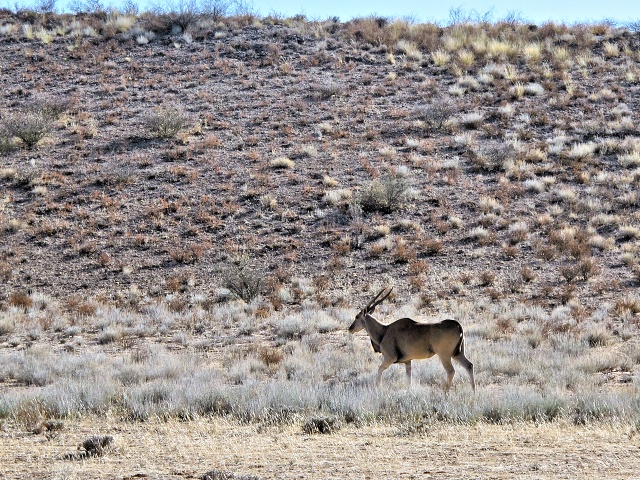
[Kgalagadi Transfrontier Park] Eland
In the morning, the animals are the most active. They move to the watering holes, so there is always something to look at. But, in combination with driving on the rather difficult road, this is a demanding task, so it is definitely better if at least two persons are in the car. One drives while the other looks at everything flying above or running around. The animals come very close to the roads, sometimes blocking the road and sometimes even showing their displeasure when forced to leave the road to make way for a slowly passing car.
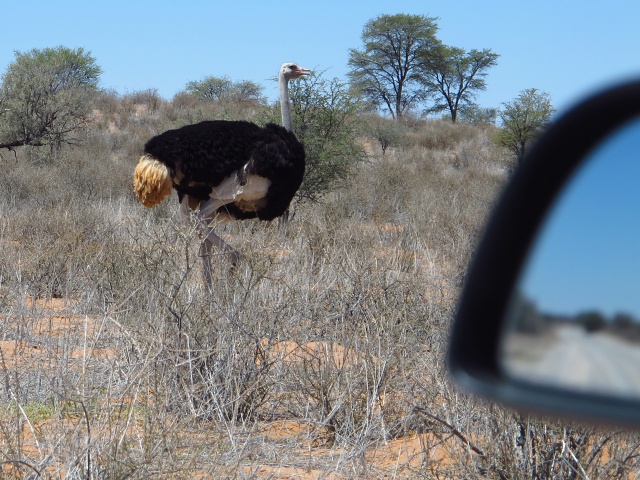
[Kgalagadi Transfrontier Park] Ostrich scolding me because I made it get out of the road so that I could pass

[Kgalagadi Transfrontier Park] One could almost touch the animals

[Kgalagadi Transfrontier Park] Springbok
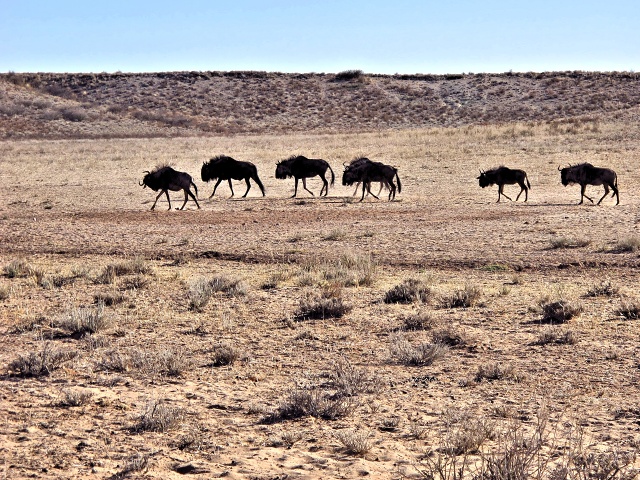
[Kgalagadi Transfrontier Park] A herd of Wildebeest (Gnu) goes to the waterhole
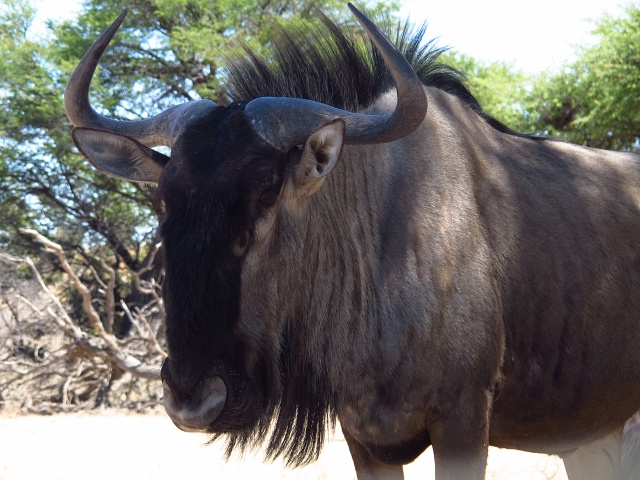
[Kgalagadi Transfrontier Park] This Wildebeest nearly poked his head through the open car window
Buried in the Sand
After 40 km, the road deteriorated a lot, a thick layer of sand was added and my vehicle got stuck in it. I was hopelessly buried in the sand, and could not move either forwards or backwards. Some guys of about my age arrived, traveling in a 4WD and equipped with shovels, ropes and everything possible. And they immediately began to solve the problem with gusto, shoveling away the sand and wanting to hitch me up and tow me out with the rope. I sheepishly asked if they could wait with this and lend me a pressure gauge and that I had forgotten to deflate the tires. And indeed, after the pressure reduction, the car dug itself out. After that, the drive was perhaps challenging and interesting, but problem-free. There was an abundance of wildlife. It was wonderful, but unfortunately, no lions.
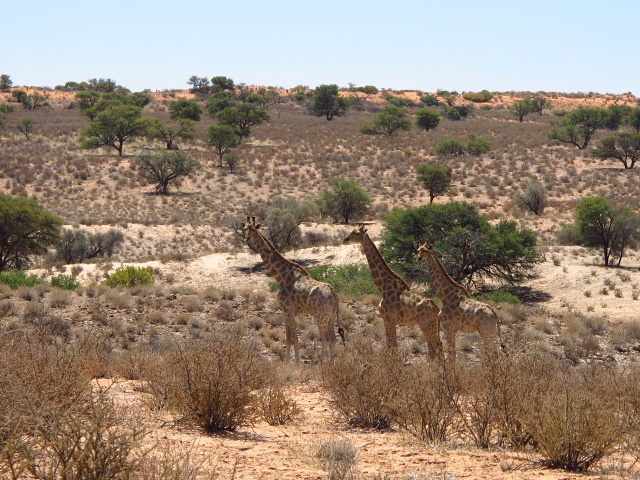
[Kgalagadi Transfrontier Park] Giraffe - supposed to be at Mata-Mata- seen here
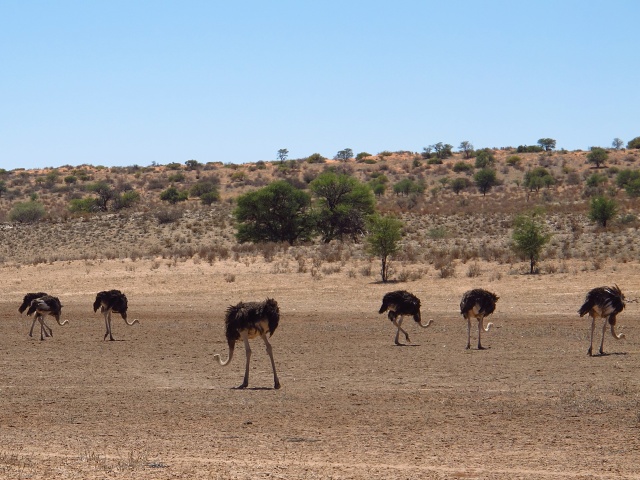
[Kgalagadi Transfrontier Park] Ostriches seeking food
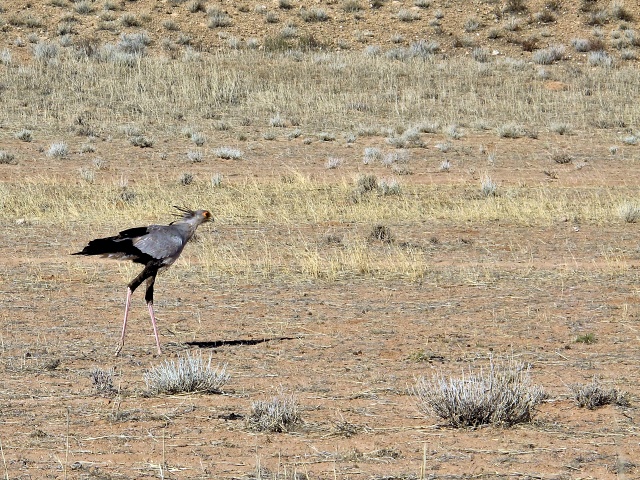
[Kgalagadi Transfrontier Park] Secretary Bird
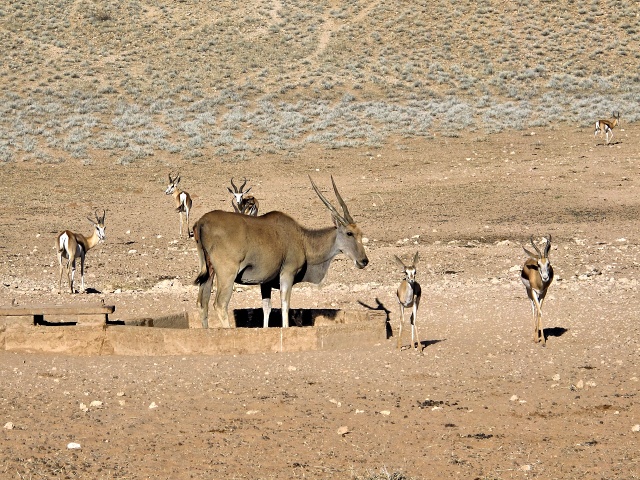
[Kgalagadi Transfrontier Park] Eland and Springbok at the waterhole
At Cockcrow
Next day I set the alarm for 5.30 a.m. I did not waste any time having breakfast and immediately after the gate opened at 6 a.m. I was given a permit and was soon on the Botswana route in the direction of Nossob. Permits had to be returned to the gate every evening and in the morning picked up again and the gate had to be informed about one's intended route. This ensures that tourists will not get lost in the Park and that those who do not return to the rest camp in the evening, will be searched for. I wanted to travel about 30 km and then return. The animals just lie down under the trees at noon anyway and, by evening, I already wanted to be back in Upington.
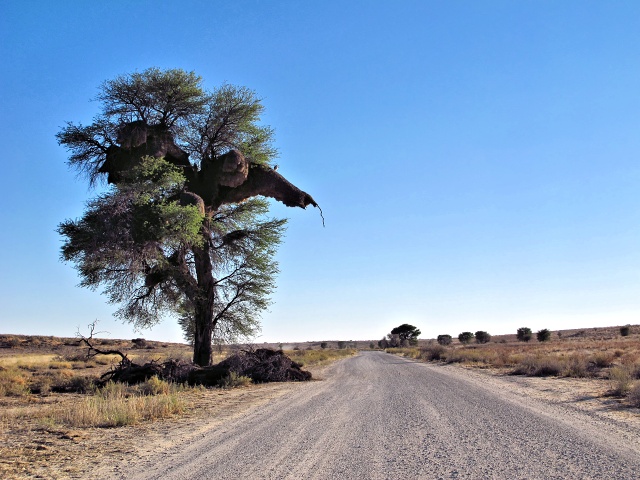
[Kgalagadi Transfrontier Park] The trees weighed down with Weaver Bird colonies, so massive that the branches often break
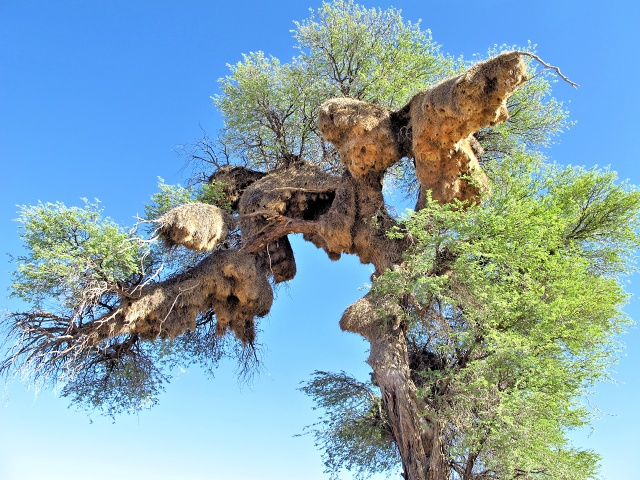
[Kgalagadi Transfrontier Park] Tree weighed down by Weaver Birds' nests

[Kgalagadi Transfrontier Park] The nest is actually a block of flats composed of many small nests
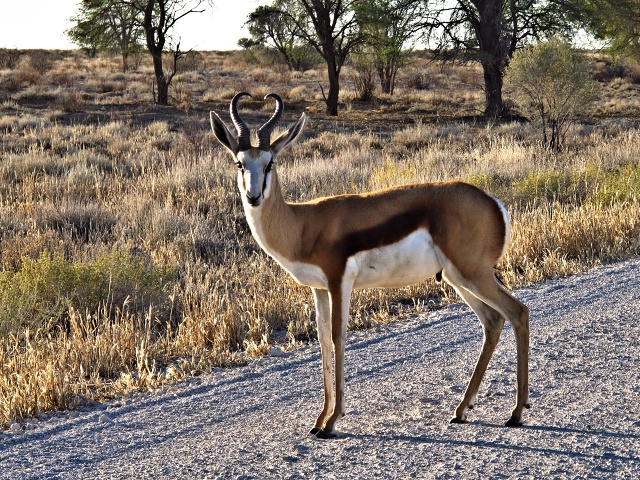
[Kgalagadi Transfrontier Park] This young male lost the fight, so now sulks in the road

[Kgalagadi Transfrontier Park] Ostriches take a morning break
At the Twelfth Hour
I drove up to Rooiputs waterhole, from where I planned to return to the rest camp. I watched a brown hyena and some jackals feasting on a carcass. I was there for about half an hour, when suddenly the large hyena sniffed in the air, left everything and ran away.

[Kgalagadi Transfrontier Park] Brown Hyena feasting

[Kgalagadi Transfrontier Park] Black-backed Jackal
I started my car with a sigh, thinking that I probably would not see any lions. I had just driven about 10 meters when a lioness appeared from among the trees. I quickly drove back and across the road, about 50 meters ahead of me, a pack of 10 lions walked past. Two or three were lions and the rest were lionesses. I was absolutely astonished. They moved regally, obviously not afraid of anything, as if they owned the place. They walked leisurely as if on a promenade, lazily swinging their tails. It just radiated from them that nothing could happen to them, that nobody could threaten them. Yes, the 'King of the Jungle' is a fitting nickname, they really behave in a classy manner. They reached the waterhole, lay down in the shade and, about ten minutes later, slowly began trickling over the hill into the next valley. Well, the trip was definitely worthwhile, just for this sight. I was really lucky, about 500 lions live in the vast territory and I had seen a few of them. I could return to Upington with an easy conscience.

[Kgalagadi Transfrontier Park] Suddenly the first lioness appears
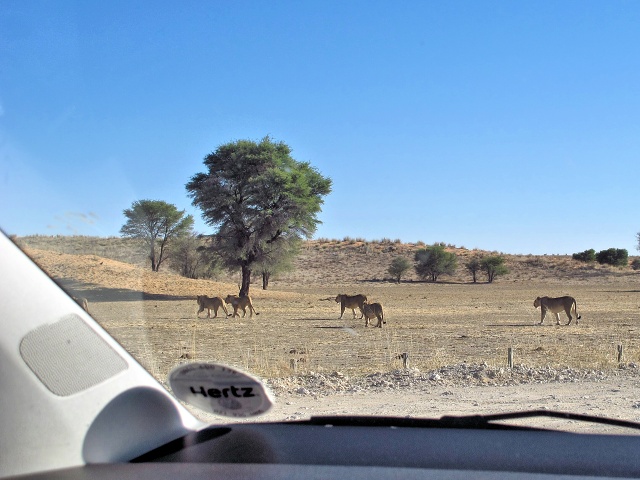
[Kgalagadi Transfrontier Park] The whole pack of lions crosses the road

[Kgalagadi Transfrontier Park] I persevered, to see the King of the Jungle here in the desert

[Kgalagadi Transfrontier Park] Lions at the waterhole
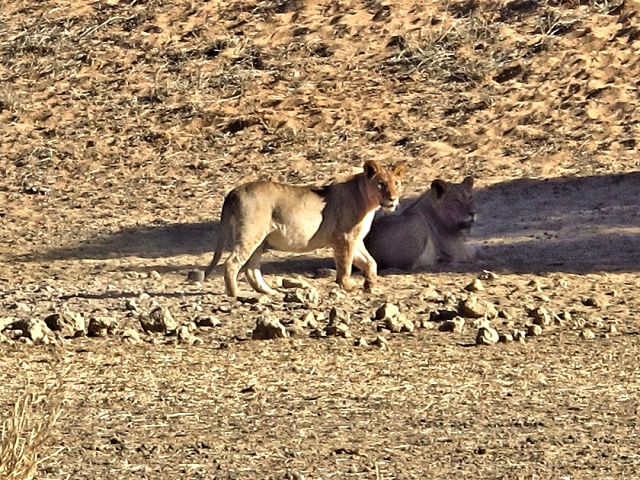
[Kgalagadi Transfrontier Park] Lion with lioness
Car versus Bike
Car travel is very different. I arrived in the campsite and nobody spoke to me. I was simply some dullard arriving in a small car and with incomprehensibly small tent. When I arrived by bike, I had to strive to cut conversations short, so that I could cook and do something else as well. The car indeed has its advantages. One does not have to maintain meticulous order, just throw everything inside and it certainly will be found after some rummaging.
This is not possible on the bike. I have six bags (two in front, two at the back, one on the handlebars and the last one on the carrier). Each has a specific purpose. The technical bag in front contains spare parts and components for the bike and cooker. In the left front bag, I carry clothes, including jacket and rain trousers, medicines, water filter, gloves for the wind and rain, and a little spare towel. I open this bag from time to time. In the left rear bag I carry the laptop, Kindle, chargers, civilian clothes and boots, softshell jacket, a small lightweight rucksack and toiletries. In the right rear bag, I have the food and pots. In the bag on the carrier, I have a tent, sleeping bag, ground sheet, t-shirt and sleeping trousers and an empty sack for water. On the handlebars, I carry the camera, GPS navigation, knife, bike tools and hand disinfectant, so that I can eat like a civilized human being en route. And I am consistent and never regret the effort always to return everything to its respective bag, otherwise I would spend too much time searching.
Day of Servicing
In the morning, I filled the tank and drove to the Airport. I had lost a hubcap from the left front wheel and wondered whether they would charge me for this. The hubcap had been scratched, which we wrote into the protocol during the handover of the car and I wanted to use this as an argument when returning the car. However, there was no-one in the Hertz office. I left the car in the parking lot. To be certain, I photographed it from all sides, and threw the keys into the designated box. I was curious whether they would charge me for the hubcap. They behaved very cordially, probably recognizing that the loss was the consequence of the previous damage to the hubcap. Collecting my bike was also problem-free, although the boss of the security workers had to assist me, as the normal workers did not have this procedure described in the manual.
I changed the chain, cleaned everything and greased it, checked the tightening of the racks and tested the brakes. It was a Sunday, so I could not find any Internet access in the town. The best hotel in the town advertised Internet access. I paid 60 Rands for 100 MB, but it did not work and so the fee was refunded. Another stop was at KFC, where I first had a salad and then tried to connect. Unfortunately it did not work there either, although I was connected to the network, the Internet was not functioning. Diagnostics reported a possible problem with DNS, so I deleted DNS memory but there was no change. I tried to connect via Kindle but the Internet was unavailable there as well. This soothed me, as the error was obviously not on my computer.
The last possibility was the Wimpy fast food restaurant which advertised 30 minutes free. First I tried the Kindle and it worked. I also successfully connected the laptop and only then had some fish for dinner. I managed everything in half an hour. Although it was possible to continue using the Internet at a low fee, it was getting dark outside and the campsite was half an hour away. I try to avoid walking in the streets after dark. I completed the day by servicing my own body by swimming a few lengths of the camp's swimming pool. The young Africans watching me had a great laugh at me, madly cheering me on as if I was in a race. To add to their pleasure, I did a few starting dives into the pool. They eventually invited me for some grilled boerewors and we had a pleasant chat. I described a few of the social advantages of my country to them and they began almost seriously to beg me to take them back to the Czech Republic with me. At 7.30 p.m. it started to rain and in addition a storm arose, so I slept peacefully.
| 



































